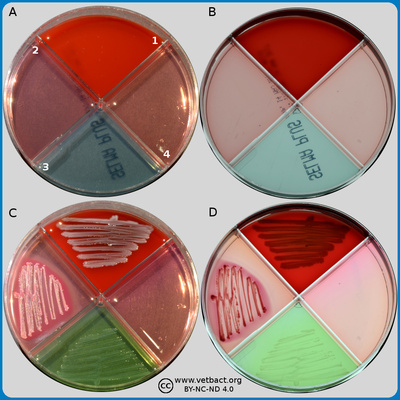SELMA PLUS plateThe figure shows two different SELMA PLUS plates under two different light conditions. Bacteria has not been cultivated on plates A and B, but on plates C and D, Escherichia coli has been cultivated. Plates A and C were photographed with a dark background and with lighting from above. Plates B and D were photographed with lighting from below. - Click on the image to enlarge it. - Click on the image to enlarge it. Image: Karl-Erik Johansson (SLU), Ingrid Hansson (BVF) and Lise-Lotte Fernström (BVF, SLU). Applications:SELMA plates are used for identification of bacteria, which may cause mastitis, and should only be used for milk samples. SELMA means SELective MAstitis medium and there are two variants of SELMA plates. SELMA, which has three sectors and SELMA PLUS, which has four sectors with different growth media. On this page, only SELMA PLUS plates are shown and the sectors are numbered on the back of the plate. The sectors contain:
Other comments:Note that E. coli is growing on all media except mannitol salt agar. Note also the colour change from blue to green in the PGUA-agarn because E. coli has a β-glucoronidase and the colour change around the colonies in the MacConkey agar because of the decreased pH. For more information, see the SVA website, and "Användarinsruktion: Sema & Selma Plus", where the plates are observed from above. Updated: 2018-05-09. |

